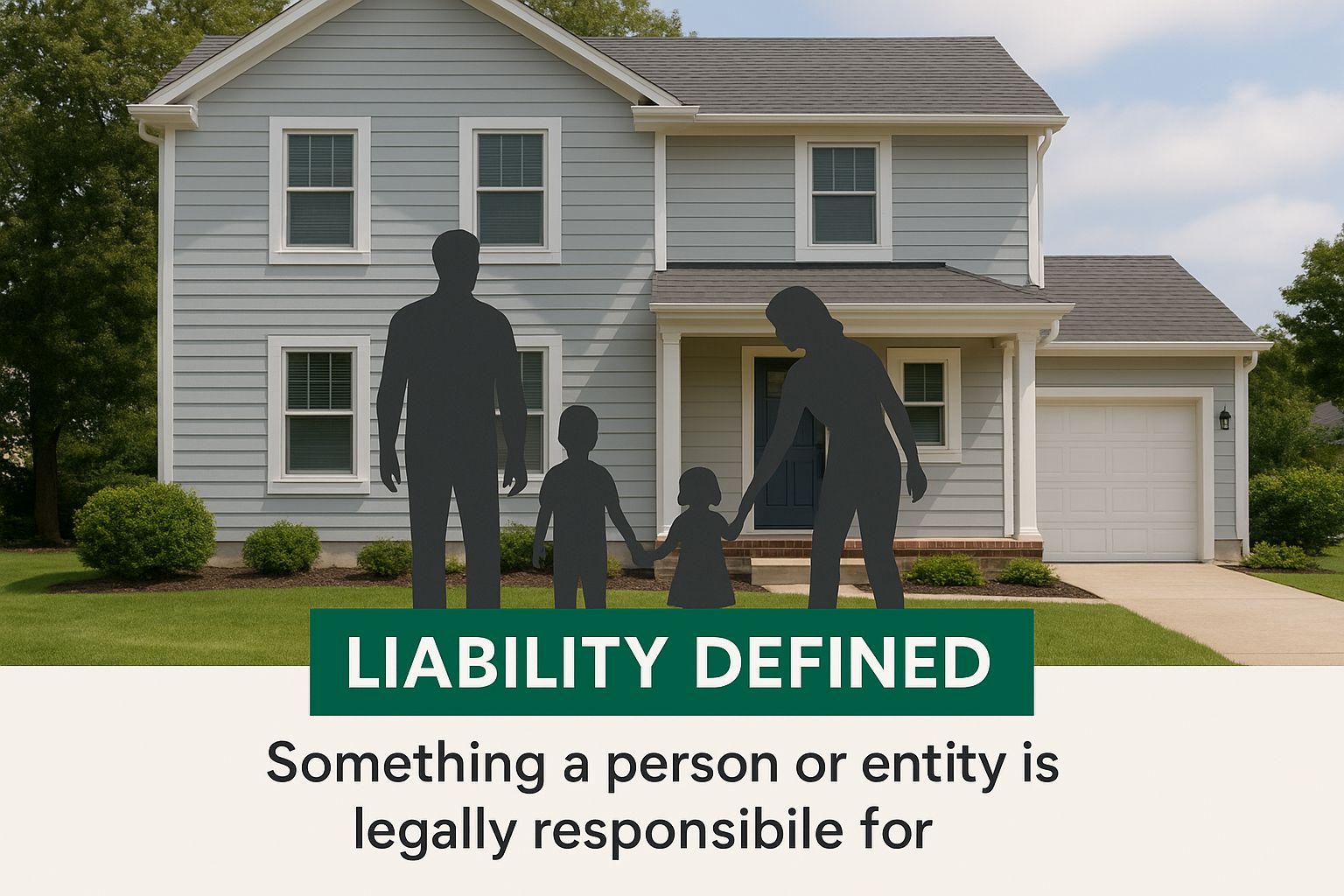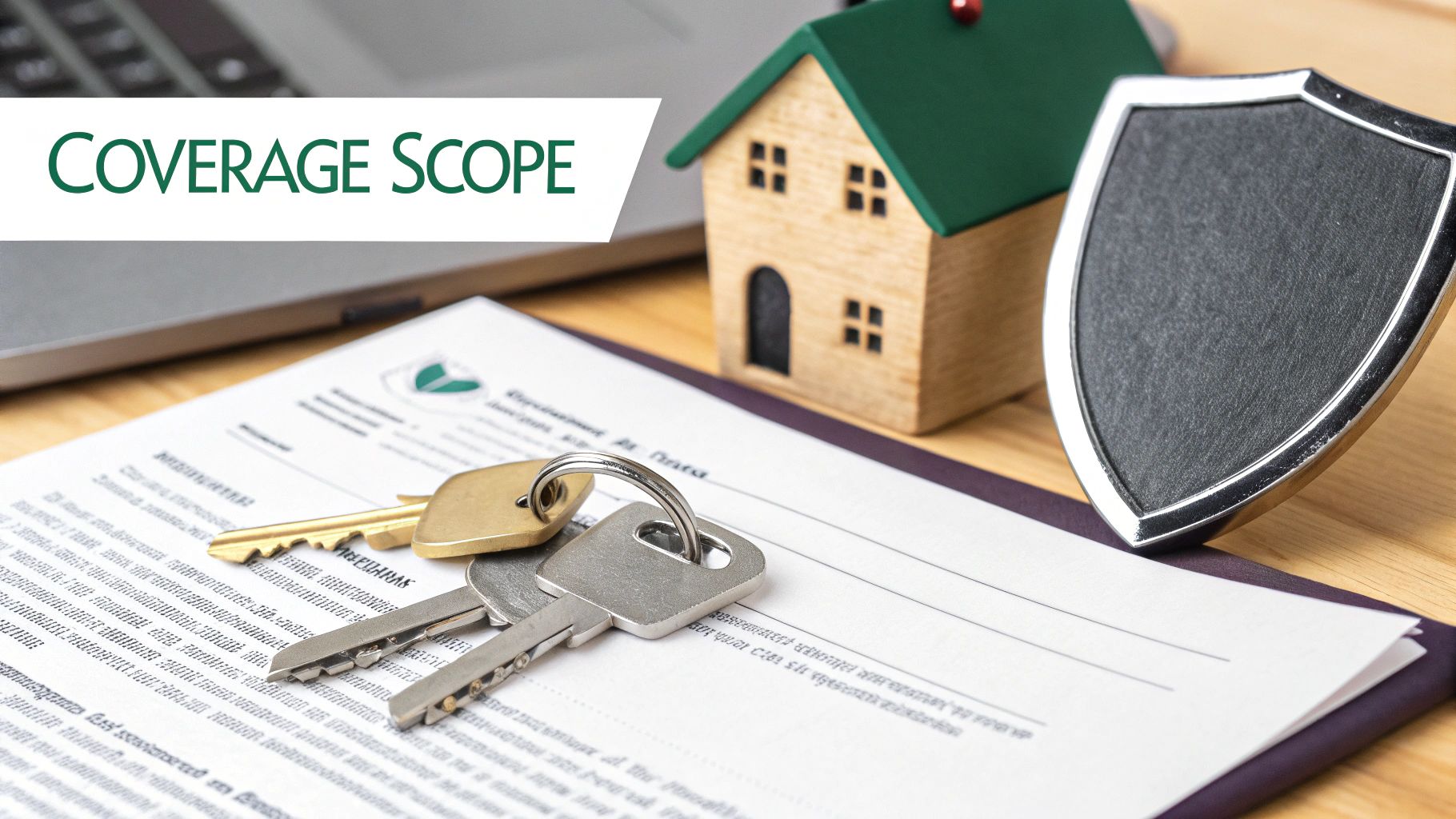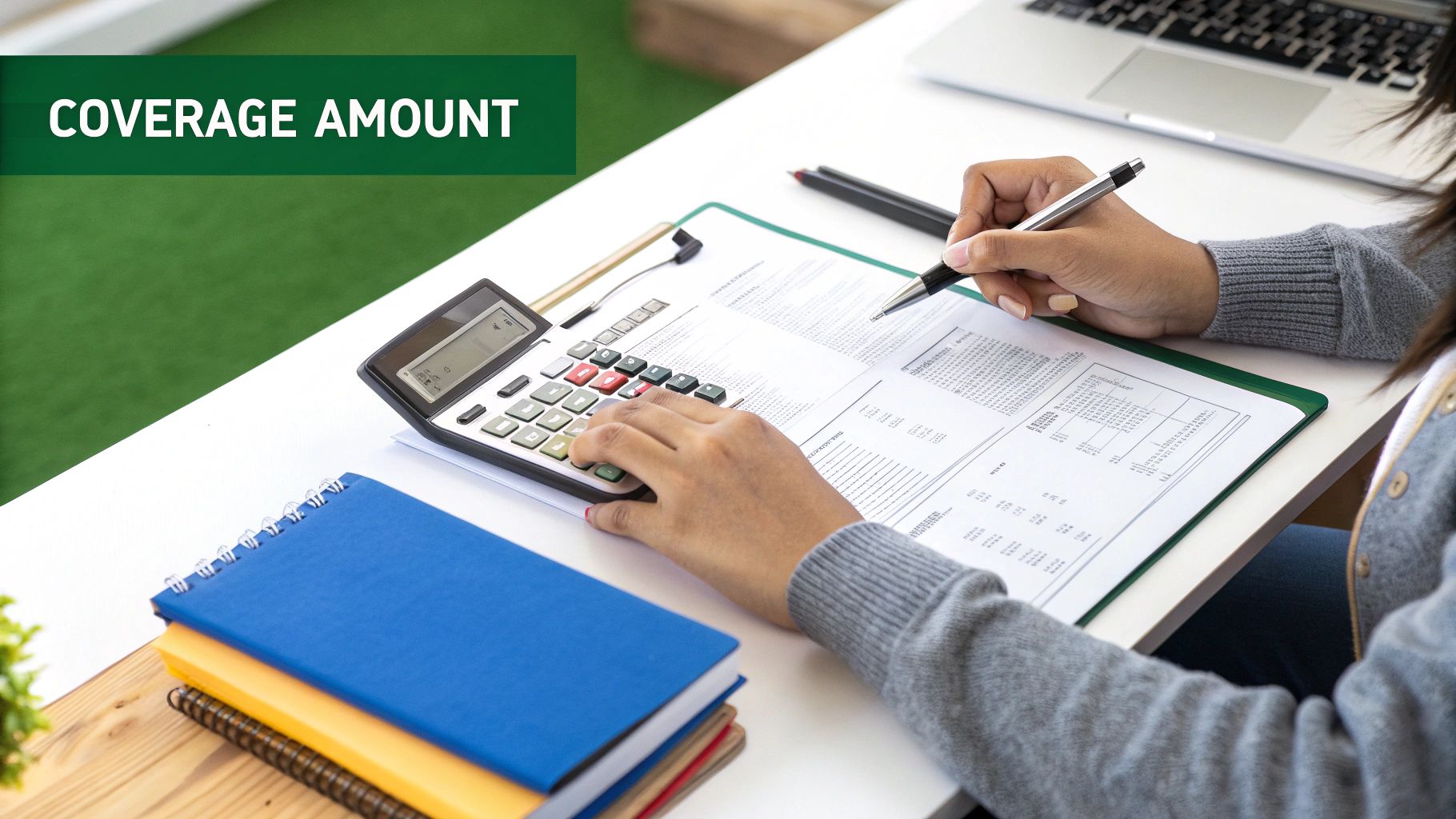Understanding Your Financial Safety Net
Imagine personal liability coverage as your financial backup plan. It's that comforting cushion that protects you from the unexpected costs that can arise from everyday accidents. Think of that time your friend tripped over a rug in your living room and sprained their ankle. Medical bills can stack up quickly, and that's where personal liability coverage comes in.
Or picture this: your child, full of youthful energy, is playing baseball in the backyard and accidentally sends a ball crashing through the neighbor's window. Replacing that window isn't cheap. These situations, while completely accidental, can put a strain on your finances.
This type of coverage is designed to help pay for the expenses associated with accidents that happen on your property, or even those you accidentally cause elsewhere. This could include things like medical bills for injuries, repair costs for property damage, or even legal fees if someone decides to sue you. It's not about admitting you're at fault. It's about having a safety net in place to protect your assets and your financial well-being.
Interestingly, the concept of personal liability coverage wasn't always around. It actually has a history, evolving over time as legal systems started to place more emphasis on compensating people for accidental harm. By the mid-20th century, it became a standard feature of home and auto insurance policies in many countries, like the United States, the United Kingdom, and Australia. Discover more insights about the history of personal liability coverage. This evolution shows how important this protection has become in our increasingly complex world. Understanding this coverage is key to anyone wanting to achieve a sense of financial security. We'll dive into the components and real-world applications of personal liability coverage in the following sections. It could be the difference between navigating an accident smoothly and facing a financial setback.
The Building Blocks of Your Protection
Understanding personal liability coverage doesn't have to be a headache. Instead of getting bogged down in technical jargon, let's think of it as a safety net, a multi-layered shield protecting you from financial woes. Take a look at this infographic to visualize the concept:
As you can see, it helps safeguard you and your family from unexpected costs associated with accidents you might cause, covering both bodily injury and property damage.
Bodily Injury Protection
This part of your coverage takes care of the financial fallout if someone gets injured because of something you did (or didn't do). Imagine a friend visiting your home slips on an icy patch on your porch and breaks their leg. Bodily injury protection helps cover their medical expenses, lost wages, and even pain and suffering. And this protection travels with you! It’s not just limited to your property. So, if your dog bites someone at the park, you're still covered.
Property Damage Coverage
This component deals with situations where you accidentally damage someone else's property. Picture this: you’re backing out of your driveway and accidentally clip your neighbor’s fence. Property damage coverage steps in to help pay for the repairs. It's not just about fences either; it covers all sorts of things, from replacing a shattered window to a damaged piece of furniture.
Legal Defense Costs
Here’s a crucial piece of the puzzle that often gets overlooked: coverage for legal defense costs. Even if you’re not at fault, defending yourself in a lawsuit can drain your bank account. This part of your coverage helps pay for attorney fees, court costs, and other legal expenses. It's like having a financial shield even in complicated legal battles. For more on specialized legal coverage, check out our article on management liability coverage.
To really grasp how these pieces fit together, let’s dive into a breakdown of each component:
Personal Liability Coverage Components Breakdown
A detailed comparison of the main components of personal liability coverage and what each protects against.
| Coverage Component | What It Covers | Typical Limits | Real-World Example |
|---|---|---|---|
| Bodily Injury Protection | Medical expenses, lost wages, pain and suffering of someone injured due to your negligence | $100,000 – $500,000 (or higher) | Your dog bites a delivery driver, resulting in medical bills and lost income. |
| Property Damage Coverage | Damage you cause to another person's property | $50,000 – $100,000 (or higher) | You accidentally back your car into your neighbor's fence, requiring repairs. |
| Legal Defense Costs | Attorney fees, court costs, and other legal expenses related to a covered claim | Often included as part of the overall liability limit | Someone sues you after tripping on your sidewalk, even if you believe you’re not at fault, legal defense costs can be significant. |
This table helps clarify what each part of your coverage protects, along with typical coverage limits and real-world scenarios. Remember, these limits can vary, so it's always best to discuss your specific needs with an insurance professional.
Now, let’s talk numbers. Understanding coverage limits and deductibles is essential. Your coverage limit is the maximum amount your policy will pay out for a covered claim (e.g., a $300,000 limit means the policy will pay up to that amount). Deductibles, typically applying to property damage you cause, are the amount you pay out of pocket before your coverage kicks in.
Finally, don't forget about exclusions. Your policy won’t cover everything, and some of these exclusions might surprise you. For instance, if you run a business from home, your standard personal liability coverage might not apply. Therefore, carefully reviewing your policy is crucial.
When Life Happens: Real Scenarios That Trigger Coverage
Personal liability coverage. It sounds like something you file away and forget about, right? Like that emergency flashlight in the back of your closet. You know it's there, but you don't really think about it until the power goes out. Well, think of a liability claim as your personal "power outage." It's when you suddenly realize just how important that coverage really is.
Let's say a delivery driver slips on your icy steps and breaks their wrist. Ouch. Suddenly, you're dealing with medical bills and possibly even a lawsuit. This is exactly when your personal liability coverage kicks in, shifting from a dusty policy document to your financial safety net.
And it’s not just about what happens on your property. Imagine your usually sweet dog gets spooked and nips a jogger in the park. Your liability coverage can help cover the jogger's medical expenses. Or, picture this: you're trying to parallel park on a busy street and accidentally back into your neighbor's expensive garden gnome. Property damage coverage, a part of your liability protection, can help cover the cost of replacing it.
But those are just the tip of the iceberg. Personal liability coverage protects you in situations you might not even consider. What if your child is playing at a friend's house and accidentally breaks a valuable antique? Or a storm knocks a tree from your yard onto your neighbor's roof? These unexpected events are precisely when liability coverage proves its worth.
The truth is, accidents happen. And sometimes, they lead to lawsuits. In fact, personal injury lawsuits are incredibly common, and many stem from everyday incidents like slip-and-falls. It's a sobering statistic to consider: one in five personal injury lawsuits are related to these kinds of accidents. Discover more insights about liability claims.
So, what happens when you need to use your coverage? It's thankfully straightforward. You file a claim with your insurance company, and they investigate the situation, assess the damages, and determine what’s covered under your policy. Understanding this process beforehand can take a lot of the stress out of a difficult situation. In the next section, we'll explore what can happen if you don't have enough personal liability coverage.
The True Cost Of Being Unprotected
Let's talk about the potential financial impact of not having enough personal liability coverage. Imagine someone slips and falls on your icy front steps and gets seriously hurt. They need extensive medical care, and suddenly, you're facing a mountain of medical bills.
This isn't just a hypothetical scenario. Medical costs alone for these kinds of claims can easily top $20,000, and if you factor in legal defense, you could be looking at an additional $10,000 to $30,000.
In fact, back in 2020, the average personal liability claim for things like property damage or bodily injury was over $30,000. This is one reason why around 20% of US households now have umbrella policies, which provide higher coverage limits. Discover more insights about liability claims.
Even Small Incidents Can Have Big Costs
Even seemingly minor incidents can become surprisingly expensive. Think about a small fender bender. You have repair costs for your car, possible medical expenses for the other driver, and maybe even lost wages if they can't work. These costs can quickly snowball.
What if something more serious happens, like a fire at your house that you're held liable for? The costs in that scenario could be financially devastating.
Understanding Your Coverage Limits
This is why understanding your coverage limits is so crucial. Choosing the minimum coverage might seem like a good way to save money upfront, but it could leave you vulnerable if a major claim arises.
Let's say your liability limit is $100,000, and a judgment against you is $250,000. You're personally responsible for that $150,000 difference. That’s a significant amount of money to come up with out of pocket.
You might be interested in learning more about how much umbrella insurance you might need: How Much Umbrella Insurance Do I Need?
The Importance of Umbrella Policies
This brings us to umbrella policies. They act as an extra layer of protection on top of your standard homeowner's or auto insurance. Think of it like a safety net for your finances, protecting your assets and future.
Umbrella policies are becoming increasingly common, and not just for the wealthy. Many middle-class families are realizing the value of this added financial security.
Let's look at some average claim costs to get a clearer picture:
Average Liability Claim Costs By Incident Type
Statistical breakdown of typical costs for different types of personal liability claims
| Incident Type | Average Medical Costs | Average Legal Costs | Total Average Claim |
|---|---|---|---|
| Slip and Fall | $15,000 | $10,000 | $25,000 |
| Dog Bite | $8,000 | $7,000 | $15,000 |
| Car Accident | $20,000 | $15,000 | $35,000 |
| Property Damage (Fire) | $50,000 | $25,000 | $75,000 |
This table represents average costs and can vary significantly depending on the specifics of each case.
As you can see, the costs can vary quite a bit depending on the incident. This highlights the importance of assessing your individual needs. In the next section, we'll explore how to choose the right coverage for your specific situation.
Choosing Coverage That Actually Fits Your Life
Let's talk personal liability coverage. It's not a one-size-fits-all kind of thing. Everyone's situation is different – like choosing the right pair of shoes. You wouldn't wear slippers to climb a mountain, and you shouldn't rely on the same liability coverage for every stage of your life. Your needs will change depending on your lifestyle, what you own, and the potential risks you face.
Evaluating Your Options
So, how do you figure out the right amount of coverage? Well, first take stock of your assets. What do you own that needs protection? A house? A car? Expensive jewelry? Savings accounts? These are all things to consider.
Then, think about your everyday life. Do you have pets? Do you entertain guests often? Do you participate in any activities that could potentially lead to accidents? These factors can all influence your risk level.
Homeowner's Liability Vs. Umbrella Policies
There's an important distinction between standard homeowner's liability coverage and what are called umbrella policies. Think of homeowner's liability as your basic protection – it covers common incidents that might happen on your property. An umbrella policy, on the other hand, is like adding an extra shield. It provides a higher level of coverage for larger claims that exceed the limits of your basic homeowner’s policy. Think of it like adding a booster shot to your existing protection. You can learn more here: What Does a Personal Umbrella Policy Cover?
Avoiding Common Mistakes
There are a few traps people often fall into when it comes to liability coverage. Some assume the priciest option is always best. Others think the minimum coverage will be enough. Both of these can be mistakes. Minimum coverage might not protect you adequately if something serious happens, and the most expensive policy might include coverage you don't actually need.
The real goal is to find the sweet spot – the right balance between being protected and keeping costs reasonable. And that comes down to understanding what your personal liability coverage definition really means and how it applies to your specific situation. In the next section, we’ll explore how Wexford Insurance Solutions can guide you through this process.
How Wexford Insurance Solutions Simplifies The Process
Thinking about personal liability coverage can be confusing, like trying to assemble furniture with missing instructions. Wexford Insurance Solutions is here to make the process clear and easy. We're your guide, helping you navigate the complexities of protecting yourself and your assets.
Personalized Guidance Every Step of the Way
We know everyone's situation is unique. That's why we don't believe in cookie-cutter insurance solutions. Our experienced team takes the time to understand your specific needs. Whether you're a homeowner, renter, or business owner, we'll work with you to find the right level of coverage. It's like having a personal shopper for insurance – we find what's best for you, not just what's easiest to sell.
We'll explain what personal liability coverage is in plain English, without the jargon. Simply put, it's a safety net that helps protect you financially if you're held responsible for someone else's injury or property damage.
Comparing Coverage Options
We work with multiple insurance carriers, comparing policies side-by-side to find the best balance of coverage and cost. Imagine going to a department store that carries many different brands – you have more choices and can find the perfect fit. We do the comparison shopping for you, saving you time and effort.
Competitive Rates and Comprehensive Protection
We understand that budget is a key concern. Our goal is to provide comprehensive protection without breaking the bank. You shouldn't have to choose between protecting yourself and paying your bills. We work hard to find affordable rates that still offer strong coverage.
Ongoing Support When You Need It Most
Life throws curveballs. You might buy a new house, get married, or acquire valuable possessions. As your life changes, so do your insurance needs. We're here to provide ongoing support and help you adjust your coverage accordingly. Think of us as your long-term insurance partner, always ready to answer your questions and help you stay protected.
Your Action Plan For Better Protection
Now that we've explored what personal liability coverage really is, let's talk about how to make it work for you. Think of this like mapping out a route for a road trip – we need to know where you are now, where you want to go, and the best way to get there.
Review Your Existing Policies
First, grab your homeowner's or renter's insurance policy. It's probably in a drawer somewhere! Find the section on personal liability coverage. Think of this like checking the fuel gauge before a long drive. What's your current coverage limit? Is it $100,000, $300,000, or a different number altogether? Does this amount truly reflect your current assets and potential risks? Imagine that fuel gauge – does it have enough for the journey ahead?
Questions for Your Insurance Agent
Next, pick up the phone and chat with your insurance agent. Don't be shy! Ask them specific questions about your coverage. What's included, and more importantly, what's not? Are there any exclusions that could catch you off guard, like potholes on our road trip? What would happen in a worst-case scenario, like a lawsuit with a judgment larger than your coverage limit? This is like knowing what to do if you get a flat tire.
Red Flags Indicating You Need More Coverage
Certain life events can be like adding weight to your car – they can signal a need for more coverage. Have your assets grown significantly? Maybe you bought a second home or inherited something valuable. Have you started a family? These changes often mean it's time to re-evaluate your liability coverage – like upgrading to a bigger vehicle for a growing family.
Considering Umbrella Coverage
An umbrella policy offers an extra layer of protection, like having a spare tire in the trunk. It goes beyond your basic homeowner's or renter's insurance and kicks in when your primary coverage maxes out. If you have valuable assets to protect, an umbrella policy offers valuable peace of mind.
Balancing Protection and Budget
Just like choosing the right car for your needs and budget, you need to balance comprehensive protection with what's affordable. Don't simply pick the cheapest policy or assume the most expensive is the best. Talk it through with your insurance agent to find the right coverage that fits both your budget and your need for protection. This will let you enjoy the journey without worrying about unexpected costs.
Ready to secure your financial future? Connect with Wexford Insurance Solutions today. Get a personalized quote from Wexford Insurance Solutions.
 How to Lower Home Insurance Premiums: Top Tips & Tricks
How to Lower Home Insurance Premiums: Top Tips & Tricks Workers Compensation Requirements Florida: What You Need to Know
Workers Compensation Requirements Florida: What You Need to Know








